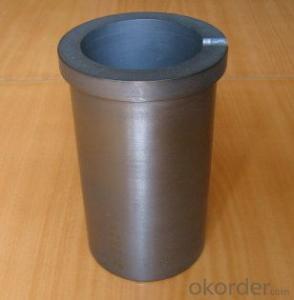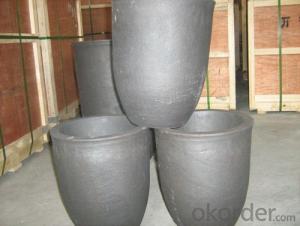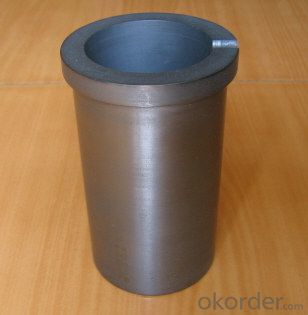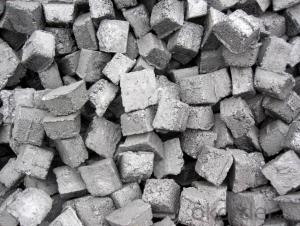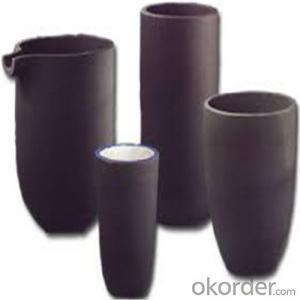Graphite Crucible For Melting Gold、Silver 、Copper
- Loading Port:
- Tianjin
- Payment Terms:
- TT OR LC
- Min Order Qty:
- 0 m.t.
- Supply Capability:
- 100000 m.t./month
OKorder Service Pledge
OKorder Financial Service
You Might Also Like
Features
1.Long working lifetime: its working lifetime is increased 3-5 times over normal clay-crucible due to the compact body formed under high pressure.
2.High thermal conductivity: high-density body and low apparent porosity greatly improve its heat conductivity.
3.New-style materials: new heat conduction material ensures faster heat conductivity and pollution-free product, reduces adherent slag.
4.Resistance to corrosion:better anti-corrosion than normal clay-crucible.
5.Resistance to oxidation: advanced process dramatically improves its oxidation resistance, which ensures persistent heat conductivity and long working lifetime.
6.High-strength: high-density body and logical structure make the product better compression property.
7.Eco-friendly: energy-efficient and pollution-free, not only ensure metal product purity, but also ensure sustainable development on environment.
8.Multi-function: Can be used in induction graphite crucible furnace
Packaging & Delivery
Packaging Details: | wooden box,usually according to detailed product. |
Delivery Detail: | Within 35 days after payment. |
Specification
Bulk Density | g/cc | 1.70-1.88 |
Specific Resistance | μΩ.m | 6.0-15.0 |
Compressive Strength | MPa | 30-80 |
Bending Strength | MPa | 20-45 |
Shore hardness | 30-70 | |
C.T.E.(100-600°C) | x10-6 /°C | 2.5-5.5 |
Ash | % | 0.01-0.2 |
Maximum Grain Size | mm | 0.044-0 |
Our services
Close customer contact through a global marketing network covering more than 90 countries
Professional technical and individual advice provided at customers‘ own sites
Detailed design proposals to solve customer-specific problems
Application-oriented training in key applications and special literature
Extensively equipped laboratories for analyses
Reliable and flexible delivery service
We can manafacture and export graphite electrodes in different grade ,shape and dimension.Whenever you need it ,please feel free to let us know.we promise you the top quality and lower price.

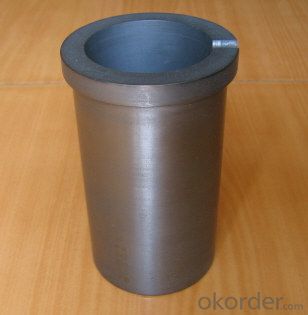
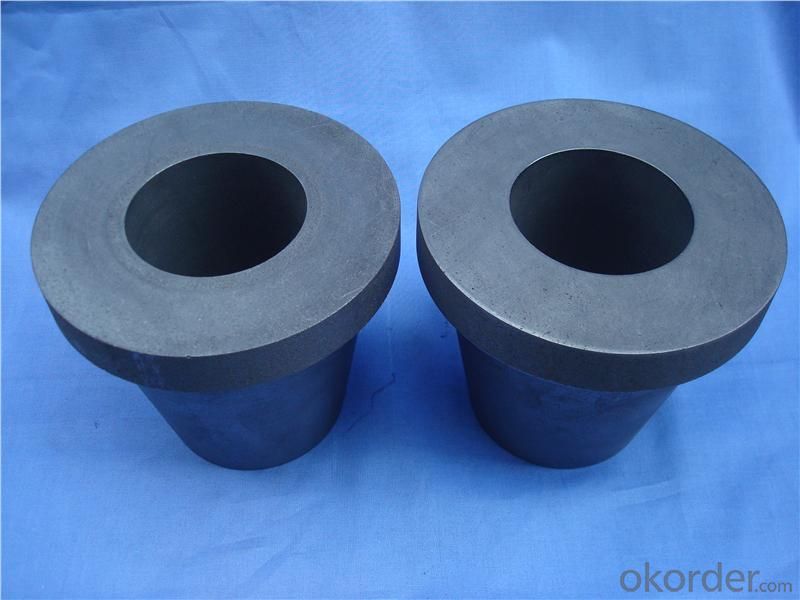
- Q: How is carbon used in the production of filters?
- Carbon is used in the production of filters due to its highly porous nature and ability to adsorb impurities. It acts as a powerful adsorbent, attracting and trapping contaminants such as chemicals, odors, and particles from air or water. This makes carbon an excellent material for removing impurities and improving the quality of filtered products.
- Q: What are the impacts of carbon emissions on coral reefs?
- Carbon emissions have significant impacts on coral reefs. One of the most significant consequences is the process of ocean acidification, caused by the absorption of excess carbon dioxide (CO2) from the atmosphere. As the ocean becomes more acidic, coral reefs struggle to build and maintain their calcium carbonate skeletons, essential for their structure and survival. This can lead to reduced growth rates and weakened reefs, making them more susceptible to damage from storms, disease, and other stressors. Additionally, the rising ocean temperatures resulting from carbon emissions have led to widespread coral bleaching events. When corals experience prolonged exposure to high temperatures, they expel the symbiotic algae (zooxanthellae) living within their tissues, which provide them with essential nutrients and give them their vibrant colors. Without these algae, corals become pale or completely white, a phenomenon known as bleaching. If the stressors subside, corals can recover, but if the bleaching is severe or prolonged, it can lead to coral death and the subsequent degradation of the reef ecosystem. Furthermore, increased carbon emissions contribute to the intensification of storms and other extreme weather events, which pose a direct threat to coral reefs. Stronger storms can physically damage the reefs, breaking apart their fragile structures and reducing their resilience. The resulting sediment runoff from land, often exacerbated by storms, can smother corals and hinder their ability to feed and grow. The impacts of carbon emissions on coral reefs are not only detrimental to these diverse marine ecosystems but also to the millions of people who depend on them for food, income, and coastal protection. Coral reefs support a vast array of marine life, provide a source of livelihood for many communities through fishing and tourism, and act as natural barriers against storm surge and coastal erosion. The degradation of coral reefs due to carbon emissions threatens the livelihoods and well-being of these communities, as well as the overall health and biodiversity of our oceans. To mitigate these impacts, it is essential to reduce carbon emissions by transitioning to cleaner, renewable energy sources, promoting sustainable practices on land to reduce runoff and pollution, and implementing effective management and conservation measures to protect and restore coral reef ecosystems.
- Q: What are the consequences of increased carbon emissions on educational systems?
- Increased carbon emissions have profound consequences on educational systems. One of the major consequences is the negative impact on the health and well-being of students and teachers. Carbon emissions contribute to air pollution, which can lead to respiratory problems, allergies, and other health issues. This, in turn, affects attendance rates and overall student performance. Furthermore, the effects of climate change caused by carbon emissions, such as extreme weather events and rising temperatures, can disrupt educational infrastructure. Schools may be closed or damaged due to hurricanes, floods, or heatwaves, leading to a loss of instructional time and disruption to the learning environment. In addition, increased carbon emissions contribute to the depletion of natural resources, such as water and food, which can have severe consequences for educational systems. In regions heavily reliant on agriculture, climate change can disrupt food production and availability, leading to malnutrition and reduced cognitive development in children. Lack of access to clean water can also impact sanitation in schools, increasing the risk of diseases and impacting students' ability to concentrate and learn. Moreover, the consequences of increased carbon emissions extend beyond physical health and infrastructure. Climate change is a complex global issue that requires an understanding of scientific concepts and critical thinking skills to address. However, inadequate education on climate change and its causes can hinder students' ability to comprehend and respond to this pressing issue. Furthermore, the economic impacts of climate change resulting from increased carbon emissions can strain educational systems. Governments may have to divert resources away from education to address climate-related disasters and their aftermath. Limited funding for education can lead to reduced access to quality education, inadequate facilities, and lower teacher salaries, all of which can negatively impact the overall quality of education provided. In conclusion, increased carbon emissions have wide-ranging consequences on educational systems. From the health and well-being of students and teachers to disruptions in infrastructure and access to resources, the effects of carbon emissions can hinder educational outcomes. Addressing climate change and reducing carbon emissions is crucial not just for the environment but also for the future of education.
- Q: Is there any difference between carbon plate and universal board?
- Generally referred to as "Pu plate" is "hot-rolled ordinary carbon structural steel plate", usually refers to single rolled steel plate (original flat plate). The common grades are: Q235, Q345, SS400, St12 and so on.Usually referred to as "carbon tie plate" refers to the "ordinary carbon structural steel hot-rolled coil", refers to the continuous rolling process with hot rolling mill rolling, finished products are steel coil delivery of ordinary carbon steel plate (coil).
- Q: How does carbon affect the formation of volcanic eruptions?
- The formation of volcanic eruptions can be significantly influenced by carbon. One way in which carbon impacts volcanic eruptions is through the degassing process. When magma rises to the surface, it carries dissolved gases, including carbon dioxide. As the magma moves towards the surface and the pressure decreases, the dissolved gases begin to separate, forming gas bubbles within the magma. These gas bubbles can make the magma more buoyant, facilitating its ascent and eventually leading to an eruption. In addition, carbon can also affect the viscosity of magma, which measures its resistance to flow. Magma with higher carbon content tends to have lower viscosity, making it more fluid-like and capable of flowing more easily. This reduced viscosity enables the magma to move more swiftly towards the surface, increasing the chances of an eruption. Moreover, carbon can contribute to the explosiveness of volcanic eruptions. When magma reaches the surface, it can come into contact with organic matter, such as plant material or fossil fuels, which contain abundant carbon. This interaction can result in the combustion of the organic matter, releasing additional gases like methane. These gases can further elevate the pressure within the volcano, leading to more explosive eruptions. In summary, carbon plays a crucial role in the formation of volcanic eruptions. It influences the buoyancy and viscosity of magma and can contribute to the explosiveness of eruptions. Understanding the impact of carbon in volcanic processes is vital for predicting and mitigating the risks associated with volcanic activity.
- Q: Consult the carbon content of austenite
- Pure iron carbon alloys, austenitic (A) carbon content in different grades, different temperature and different, in more than 727 degrees (727 degrees when the carbon content is 0.77%), 1148 degrees, 2.11% carbon content with see iron carbon phase diagram
- Q: What is coal?
- Coal is a black or brownish-black sedimentary rock that is primarily composed of carbon, along with various other elements such as hydrogen, sulfur, oxygen, and nitrogen. It is formed from the remains of plants that lived and died millions of years ago, accumulating in swampy environments. Over time, the layers of plant material were subjected to high pressure and heat, resulting in the formation of coal. Coal is one of the most abundant fossil fuels on Earth and has been used as a source of energy for centuries. It is typically extracted from underground or surface mines and can be found in different forms, including anthracite, bituminous, sub-bituminous, and lignite, with varying carbon content and heating value. Due to its high carbon content, coal is primarily used for electricity generation and as a fuel for industrial processes. When burned, it releases energy in the form of heat, which is converted into electricity through steam turbines. However, burning coal also releases greenhouse gases and other pollutants, contributing to air pollution and climate change. In addition to its use as a fuel, coal is also used in the production of steel and cement, as well as in various industrial processes. It is a versatile resource that has played a significant role in the development of modern societies, but its environmental impact and finite nature have led to increased efforts to shift towards cleaner and more sustainable energy sources.
- Q: How does carbon impact the prevalence of cyclones?
- Carbon emissions contribute to the prevalence of cyclones by intensifying the greenhouse effect, leading to warmer sea surface temperatures. Warmer oceans provide more energy for cyclones to form and strengthen, increasing their frequency and intensity. Additionally, higher levels of carbon dioxide in the atmosphere can alter atmospheric circulation patterns, creating more conducive conditions for cyclone development.
- Q: What are the impacts of carbon emissions on the stability of tundra ecosystems?
- Carbon emissions have significant impacts on the stability of tundra ecosystems. As carbon dioxide levels increase in the atmosphere due to human activities, such as burning fossil fuels, it leads to global warming. Tundra ecosystems are particularly vulnerable to this warming trend. The increase in temperature causes the permafrost to thaw, resulting in the release of large amounts of stored carbon into the atmosphere as methane, a potent greenhouse gas. This feedback loop intensifies climate change, further impacting the stability of tundra ecosystems. Additionally, the warmer conditions allow for the expansion of shrubs and trees into the tundra, altering the delicate balance of plant species and disrupting the habitat for specialized tundra organisms. Overall, carbon emissions contribute to the destabilization of tundra ecosystems, leading to changes in biodiversity, permafrost degradation, and potential release of more greenhouse gases, exacerbating climate change.
- Q: What are the impacts of carbon emissions on the stability of islands?
- Carbon emissions have significant impacts on the stability of islands. The primary consequence is the rise in sea levels due to global warming, leading to increased coastal erosion and flooding. Additionally, carbon emissions contribute to ocean acidification, threatening marine ecosystems that islands heavily depend on for livelihoods and food security. Moreover, the warming climate intensifies extreme weather events like hurricanes, posing a greater risk to island communities. Overall, carbon emissions destabilize islands both environmentally and economically, making them highly vulnerable to the impacts of climate change.
Send your message to us
Graphite Crucible For Melting Gold、Silver 、Copper
- Loading Port:
- Tianjin
- Payment Terms:
- TT OR LC
- Min Order Qty:
- 0 m.t.
- Supply Capability:
- 100000 m.t./month
OKorder Service Pledge
OKorder Financial Service
Similar products
Hot products
Hot Searches
Related keywords
